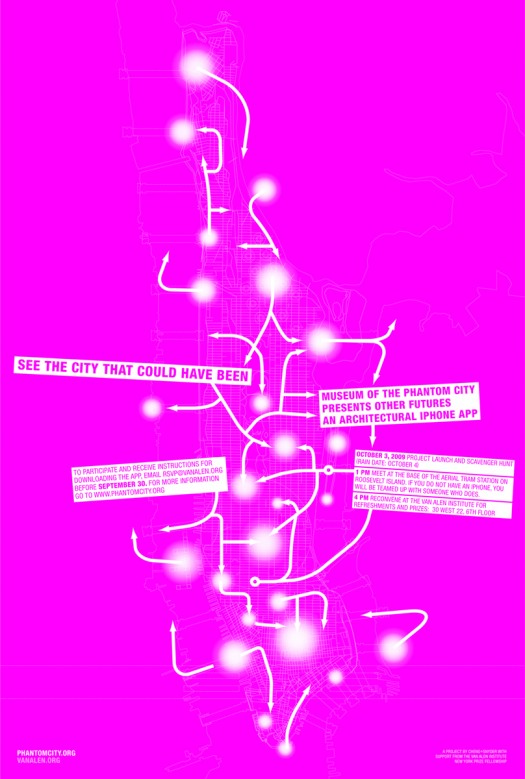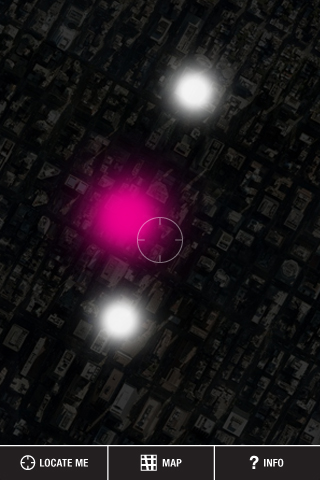
We are celebrating 15 years — and counting — of stories that are deeply researched and deeply felt, that build a historical record of what the city has been.
We are celebrating 15 years — and counting — of stories that are deeply researched and deeply felt, that build a historical record of what the city has been.
Irene Cheng and Brett Snyder designed the Phantom City iPhone app to “transform the city into a living museum of speculative proposals for the city of New York.” Here they share the inspiration for the project, give us a tour of the app, and pose questions sparked by their research. We have been intrigued by the project since it was first launched, and our curiosity persists: click here for info about a Halloween afternoon Phantom City meet-up with Cheng and Snyder that will begin in Bryant Park. In the meantime, tune in to Morning Edition on Monday, October 26 to hear Irene tell Soterios Johnson what the app is all about. Check your local listings here. –V.S.
Every building or neighborhood has a story to tell. As self-admitted archi-nerds, whenever we travel we often find ourselves wanting to know more about the places we pass. Yet as a genre, architectural information graphics seem arrested in the nineteenth century forms of the plaque and the guidebook – modes that are didactic and technologically primitive. We wondered how ubiquitous mobile devices might be harnessed to make the city’s hidden stories visible.
 Such speculations led us to develop the Museum of the Phantom City: OtherFutures – an iPhone app that lets users browse visionary designs for the City of New York on their phones. The app is now available in beta form on the iTunes store, thanks to the efforts of a multidisciplinary team of programmers, researchers, a graphic designer, and an architecture historian.
Such speculations led us to develop the Museum of the Phantom City: OtherFutures – an iPhone app that lets users browse visionary designs for the City of New York on their phones. The app is now available in beta form on the iTunes store, thanks to the efforts of a multidisciplinary team of programmers, researchers, a graphic designer, and an architecture historian.
Mobile Media and Urban Experience
iPhones and mobile devices are undoubtedly transforming the way we navigate the city. Apps like Google Maps and Urbanspoon put an unprecedented amount of information about the city at one’s fingertips. Most of these programs, however, are purely functional in purpose: they seek to clarify the city, to demystify and make it more legible. In contrast, we are interested in how mobile media can deepen and intensify urban experience, perhaps even introducing new pleasures and mysteries of the metropolitan condition. We are inspired by the work of artists and urbanists like Janet Cardiff and the Situationists, who strived to make ordinary landscapes appear unfamiliar and strange again. How might mobile media be used to reveal dimensions of the city veiled from everyday experience – to manufacture an augmented reality?
We are also interested in how architects might capitalize on the ubiquity of personal digital devices to reach an audience beyond the world of design, to inspire a greater interest in urban and design issues in the general public. Fortunately, this desire to reach a broader audience coincided with the Van Alen Institute’s mission to promote emerging works of “public architecture,” and we were able to develop the Phantom City project through the generous support of their New York Prize Fellowship.
The inaugural exhibition of the Museum of the Phantom City is OtherFutures, and it features speculative and sometimes fanciful visions of the city that were never realized. We launched the project on October 3 with a scavenger hunt sponsored by the Van Alen that began on Roosevelt Island.
 How it works
How it works
When you open the app, the first screen to appear after the initial credits is a dark, nearly black, field punctuated only by several pink and white “bursts.” The screen is intended to be a kind of terrain vague, to make you feel like you are groping through some unknown territory. On closer inspection, you might notice that the black field conceals a Google map underlay, and that it is centered on your current location. The bursts indicate sites for which a designer has created a visionary proposal at some point in the past. A pink burst means you are close enough to access the site—to see the designer’s images and words. A white burst means you are not within range: venture closer to unlock that site’s content.
(Users outside of New York City are out of luck for now, until we can get additional funding to expand the project to other cities. Though the entire archive of utopian projects is also accessible on the Museum of the Phantom City website.)
The sites include well-known projects such as Buckminster Fuller’s Dome over Midtown Manhattan and Superstudio’s Continuous Monument, as well as less famous proposals like Fuller’s “Mini-Earth”—a miniature globe that would have been suspended by cables across from the United Nations building, constantly reminding diplomats of the “bigger picture” of their actions. Or Raymond Loewy’s 1941 proposal for a helicopter landing field to be built on steel pylons over Bryant Park, which he claimed could double as an air raid shelter.
Phantom City in prospect
Combing through the archive of OtherFutures, one becomes aware of certain generational preoccupations: Visions at the turn of the twentieth century are full of soaring towers, bridges between skyscrapers, and flying machines, while mid-twentieth-century proposals, not surprisingly, reveal Cold War disquiet about bomb attacks. The 1960s generated myriad megastructures composed of prefabricated units that would purportedly leave the existing urban fabric intact.
On one level, such proposals can be viewed merely as quaint curiosities – the detritus of bygone hopes and anxieties. But on another, they serve as a pointed contrast to present-day urban proposals. Sure, an airport over Bryant Park seems far-fetched, but are we necessarily happy with the current status quo in urban transportation systems? How does the Related Companies’ West Side Railyards proposal appear when juxtaposed with Michael Sorkin’s whimsical, elegiac scheme for a homeless colony on the same site? OtherFutures provokes the question of whether our current designs for the city are imaginative enough, whether we are thinking big enough.
Users are free, however, to interpret the content of the app as they wish. A rating function allows one to vote on each proposal, and to see how others have voted: Was Paul Rudolph’s Lower Manhattan Expressway project utopian or dystopian? Beauty or beast? Yawn or yell? You decide. Then roam elsewhere and discover another city that could have been.
Project Credits: Museum of the Phantom City is a public art project designed by Cheng+Snyder with generous support from the Van Alen Institute New York Prize Fellowship.
PROJECT COLLABORATORS
Ray Cha, website programming and user interface
Michelle Chang, research and project development
Noah Keating, iPhone programming and interactive design
Olivia Wright, research and project development
Cheng+Snyder gratefully acknowledges the following for their contributions and input:
Alexander Arroyo, Inbar Barak, Maria Berman, Jessica Blaustein, Christy Cheng, Adam Dayem, Chris Dierks, Diller Scofidio + Renfro, Sam Feldman, Abby Hamlin, Jamie Hand, Elizabeth Hodges, Steven Holl, Brad Horn, Joan Ockman, Brian Schulman, Liz Shearer, Michael Sorkin, Deborah Tchoudjinoff, Alie Thomer, and Bernard Tschumi.
All images courtesy of Irene Cheng and Brett Snyder unless otherwise noted.
The views expressed here are those of the authors only and do not reflect the position of The Architectural League of New York.
Comments